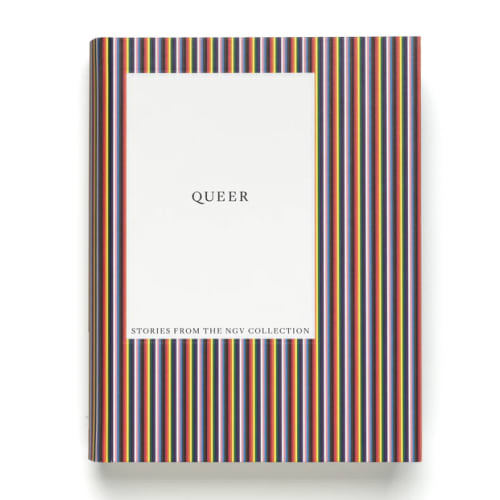All marginalised communities have one thing in common, and that is the experience of being marginalised. In Australia, oppression based on race and sexuality is only as old as colonisation. I recently saw a tweet that said, ‘Just remember, if you are homophobic, you have been successfully colonised’. In Australia, oppressions based on homophobia and racism are fundamentally settler constructs. Recognising that there is an interlocking matrix of oppres- sion, and therefore that there are both connections and diferences between the shared experiences of oppressed communities, is the frst step toward confronting inequality.
As a curator working at the NGV, I recognise that this is an ongoing project in terms of how we as an institution continue to build the people’s collection. It is impossible to pinpoint the earliest work by a queer Indigenous artist in the NGV collection. There are a small number of works in the collection by artists who identify as queer, and others by artists who lived in times when such identifcation was either not possible or not necessary. There are also many works where an artist’s sexuality is simply unknown and can only be speculated on. When early settlers arrived in Australia, they brought with them Christianity and enforced their notions of morality, gender and sexuality. As Claire G. Coleman wrote in her essay ‘Aboriginal feminism and gender’, in the NGV publication She Persists (2020), we have no direct evidence that homosexuality or transgenderism did or did not exist in Australia prior to European arrival; however, if we look at instances of these in the recorded histories of other, similarly colonised nations – Two-Spirit people in North America, and the fa’afafne (known by various names) throughout the Pacifc – it is highly likely that they did exist.
If the antidote to absence is presence, then the cure for shame is pride. The NGV recently acquired a folio of seven works by Yuwibara/Meriam Mir and South Sea Islander man Dylan Mooney from his frst solo exhibition, Queer, Blak & Here (2021). Mooney’s digital portraits are queer and Blak urban love stories. He narrates his personal experience as a queer Indigenous man, celebrating his sexuality through images that are both homoerotic and tender. Mooney sees his work as being about representation. His images promote a side of the queer and Indigenous experience that is often underrepresented in the media. He reminds us that Aboriginality and Indigeneity exist within the queer community, in just the same way that queerness has always existed for First Nations peoples.
In March 2021 @instagram (Instagram’s ofcial account) posted an image of Mooney’s work Our moment, 2020 (p. 49), sharing unapologetic queer and Indigenous pride with nearly 400 million followers. It is difcult to comprehend the impact that Instagram sharing an image like this might have for queer and First Nations people around the world. And in July 2021, Google launched a commissioned doodle by Mooney to celebrate the First Nations activist Pearl Gibbs. This was followed by Rolling Stone magazine commissioning him to create the cover of an issue celebrating the 200 greatest albums of all time. Visibility on that scale is extremely important if we are to create a world that values equality for queer and First Nations people alike.
It has never been as important to make space for queer stories as it is today. Queer people around the world, and especially queer people who are also Indigenous, Black/Blak, First Nations and so on, continue to live precarious lives and are often at extreme risk of experiencing societal discrimination. To be marginalised, at its core, means to have your life treated as if it belongs on the periphery. Queer people, like all marginalised communities, share an intersectional bond. We know our histories exist, even though we rarely see them take centrestage within mainstream society. In order to create a world that values equality, institutions like the NGV need to make space, and making space means giving up power. The power to decide whose stories are told, and perhaps even more importantly, whose stories are not told, has for too long been in the hands of a few.
It is my hope that Queer represents a type of new museology, one in which exhibition artwork labels and the stories written on them challenge audiences to consider their relationship with history. It is not the responsibility of institutions like the NGV to inscribe history, but rather to challenge it. Queer stories are human stories, just as Indigenous art is ‘art’ – and in recognising that we open ourselves up to a whole new way of viewing the world.

